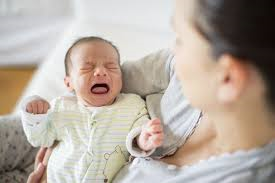 In the beginning of “Mothers,” a baby is given to the protagonist by (what we find out to be her abusive ex-girlfriend) Bad. At first, the author toys with the idea of the protagonist being a male. The protagonist is given the baby and told it is hers.
In the beginning of “Mothers,” a baby is given to the protagonist by (what we find out to be her abusive ex-girlfriend) Bad. At first, the author toys with the idea of the protagonist being a male. The protagonist is given the baby and told it is hers.
“What do you mean she is mine?”
Bad looks at me as if I am unfathomably stupid, or possibly fucking with her, or both.
“I was pregnant. Now there’s a baby. She’s yours.” (45)
However, it is revealed that the protagonist is indeed a woman as she says, “My uterus contracts in protest, confused.” (45) It is common knowledge that two females cannot make a child (without help of science, if so), therefore, it would be nearly impossible for the baby to be the narrator and Bad’s child. After Bad explains to her that she needs to take care of the child when she cried, because crying can have several meanings, she leaves.
“I am not your mother, baby,” I say, “I can’t feed you.”
I am so hypnotized by her that I miss the receding footsteps, the crack of the slamming car door. But then Bad is gone, and for once, I am not alone, after.” (46)
After their breakup, we can only conclude that the narrator was in a depressive slump as she describes the condition of her living space when Bad arrives with the child.
For months, my head has been fuzzy. Mail is stacked unread on my kitchen table, and my clothes are a giant mound on my once-immaculate floor. (45)
When she rejects the child at first, not believing it is her child. She even goes farther and has a desire to harm the child.
I pick her up and lean her against me, whispering, “I love you, baby, and I am not going to hurt you,” but the first thing is a lie and the second thing might be a lie, but I’m just not sure. I should have the urge to protect her, but all I can think about is that soft spot, that place where I could hurt her if I tried, where I could hurt her if I wanted to. (49)
Throughout the story, the narrator tells us through flashbacks of the romance between them and what made their relationship ultimately end. As she describes her memories of the flashbacks, she reminisces on the “future” she envisioned them to have while they were together. Within the “future” she imagines that they both have a child, named Mara, and Bad entertains the idea.
We would joke and call her Mara, talk about her first words and her funny hair and her bad habits. Mara, a girl. Mara, our girl. (51)
A little earlier, during a more sensual scene, the narrator expresses her gratitude that between her and Bad, they could not procreate. She even voiced her gratitude multiple times, “Thank god we cannot make a baby (15),” is stated three times throughout the scene. However, she accepts the child as theirs after describing the scene, “We made a baby. Here she is.” (51)
While they are in a relationship, she begins daydreaming of an optimistic future for their family. When she receives Mara, she continues daydreaming about their future, even though Bad is not in the image. “We were in love, and I dreamt of our future.” (51)
She starts revealing aspects of their relationship that can be viewed as abusive throughout the series of flashbacks.
The baby does look like me, and Bad – my pointy nose and brown hair, my sulky pout, her round chin and detached earlobes. The open, howling mouth – that’s all Bad. I stop, the danger of this joke still firing in my brain even as I realize that Bad isn’t here to hear it, to pause whatever she is doing to raise an eyebrow at me, maybe scold me for saying such a thing in front of our daughter, or maybe throw a glass at me head. (56)
She then describes a time when she was at school and a teacher overheard their conversation, offering her support because, “all I am saying is that it’s just not normal. I’m worried for you.” (57)
She takes me in again, my whole self into her eyes, all of my shame and pain and the truth of her mothers, the honest truth of them. (58)
In conclusion, the baby could be a representation of the hope the narrator clung to that they would have a happy ending. As she was “mourning” the relationship, in a depressive state revealed through the condition of her living space, Bad appeared with the object that she (so) desired in the relationship to remind her of the times they had together. The narrator is simply afraid of letting go the memories of their toxic relationship. She dreamed to have a family with Bad; her wish was granted with a twist and she has a broken family.
I am assuming the fantastic is that a same-sex couple made a baby while the whole of the story is about boundaries. Was this real or a consequence of the hit on the head? or from a broken heart? Complicated read.
I hadn’t thought about Mara being the only tie left to Bad, this would explain why Bad and Mara don’t coexist in the narrative together. I had wondered where the other was during the story. Especially when Bad and our narrator took a road trip after the baby came into the picture.